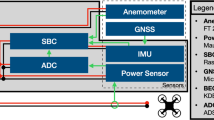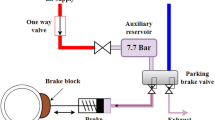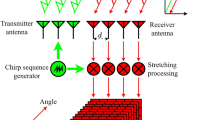Abstract
A unifying mathematical formulation is needed to move from one-off digital twins built through custom implementations to robust digital twin implementations at scale. This work proposes a probabilistic graphical model as a formal mathematical representation of a digital twin and its associated physical asset. We create an abstraction of the asset–twin system as a set of coupled dynamical systems, evolving over time through their respective state spaces and interacting via observed data and control inputs. The formal definition of this coupled system as a probabilistic graphical model enables us to draw upon well-established theory and methods from Bayesian statistics, dynamical systems and control theory. The declarative and general nature of the proposed digital twin model make it rigorous yet flexible, enabling its application at scale in a diverse range of application areas. We demonstrate how the model is instantiated to enable a structural digital twin of an unmanned aerial vehicle (UAV). The digital twin is calibrated using experimental data from a physical UAV asset. Its use in dynamic decision-making is then illustrated in a synthetic example where the UAV undergoes an in-flight damage event and the digital twin is dynamically updated using sensor data. The graphical model foundation ensures that the digital twin calibration and updating process is principled, unified and able to scale to an entire fleet of digital twins.
This is a preview of subscription content, access via your institution
Access options
Access Nature and 54 other Nature Portfolio journals
Get Nature+, our best-value online-access subscription
$29.99 / 30 days
cancel any time
Subscribe to this journal
Receive 12 digital issues and online access to articles
$99.00 per year
only $8.25 per issue
Buy this article
- Purchase on Springer Link
- Instant access to full article PDF
Prices may be subject to local taxes which are calculated during checkout






Similar content being viewed by others
Data availability
Code availability
The code used to perform the calibration procedure is available in the public repository UAV-Experimental-Calibration30. This code, when combined with the provided experimental data, can be used to generate Fig. 5 and Extended Data Fig. 1. Additionally, code used to implement the in-flight health monitoring simulation is provided in the public repository UAV-Digital-Twin31. This simulation code was used to generate the data in Fig. 6. The structural analysis software used to generate the results in this paper is Akselos Integra v4.5.9 (https://akselos.com/). Because the Akselos Integra software is proprietary and was used under license, we are unable to provide its source code. Instead, the model output data are provided directly in the repositories.
References
AIAA Digital Engineering Integration Committee. Digital Twin: Definition & Value (American Institute of Aeronautics and Astronautics (AIAA) and Aerospace Industries Association (AIA), 2020).
Rasheed, A., San, O. & Kvamsdal, T. Digital twin: values, challenges and enablers from a modeling perspective. IEEE Access 8, 21980–22012 (2020).
Tuegel, E. J., Ingraffea, A. R., Eason, T. G. & Spottswood, S. M. Reengineering aircraft structural life prediction using a digital twin. Int. J. Aerospace Eng. 2011, 154798 (2011).
Glaessgen, E. & Stargel, D. The digital twin paradigm for future NASA and US air force vehicles. In Proc. 53rd AIAA/ASME/ASCE/AHS/ASC Structures, Structural Dynamics and Materials Conference and 20th AIAA/ASME/AHS Adaptive Structures Conference 2012-1818 (AIAA, 2012); https://doi.org/10.2514/6.2012-1818
Li, C., Mahadevan, S., Ling, Y., Choze, S. & Wang, L. Dynamic Bayesian network for aircraft wing health monitoring digital twin. AIAA J. 55, 930–941 (2017).
Podskarbi, M. & Knezevic, D.J. Digital twin for operations—present applications and future digital thread. In Offshore Technology Conference OTC-30553-MS (Offshore Technology Conference, 2020); https://doi.org/10.4043/30553-MS
Bruynseels, K., Santoni de Sio, F. & van den Hoven, J. Digital twins in health care: ethical implications of an emerging engineering paradigm. Front. Genet. 9, 31 (2018).
Rivera, L. F. et al. Towards continuous monitoring in personalized healthcare through digital twins. In Proc. 29th Annual International Conference on Computer Science and Software Engineering (eds. Pakfetrat, T. et al.) 329–335 (ACM, 2019).
Barricelli, B. R., Casiraghi, E., Gliozzo, J., Petrini, A. & Valtolina, S. Human digital twin for fitness management. IEEE Access 8, 26637–26664 (2020).
Yu, H., Miao, C., Leung, C. & White, T. J. Towards AI-powered personalization in MOOC learning. npj Sci. Learn. 2, 15 (2017).
Mohammadi, N. & Taylor, J. E. Smart city digital twins. In Proc. 2017 IEEE Symposium Series on Computational Intelligence (SSCI) 1–5 (IEEE, 2017).
Darema, F. Dynamic data driven applications systems: a new paradigm for application simulations and measurements. In International Conference on Computational Science 662–669 (Springer, 2004).
Blasch, E., Ravela, S. & Aved, A. Handbook of Dynamic Data Driven Applications Systems (Springer, 2018).
Koller, D. & Friedman, N. Probabilistic Graphical Models: Principles and Techniques (MIT Press, 2009).
Russell, S. J. & Norvig, P. Artificial Intelligence: A Modern Approach (Pearson Education Limited, 2002).
Kapteyn, M. G., Knezevic, D. J., Huynh, D., Tran, M. & Willcox, K. E. Data-driven physics-based digital twins via a library of component-based reduced-order models. Int. J. Numerical Methods Eng. https://doi.org/10.1002/nme.6423 (2020).
Brunton, S. L. & Kutz, J. N. Data-Driven Science and Engineering: Machine Learning, Dynamical Systems and Control (Cambridge Univ. Press, 2019).
Dzunic, Z., Chen, J. G., Mobahi, H., Büyüköztürk, O. & Fisher, J. W.III A Bayesian state-space approach for damage detection and classification. Mech. Syst. Signal Process. 96, 239–259 (2017).
Brynjarsdóttir, J. & O’Hagan, A. Learning about physical parameters: the importance of model discrepancy. Inverse Problems 30, 114007 (2014).
Hartmann, D., Herz, M. & Wever, U. in Reduced-Order Modeling (ROM) for Simulation and Optimization (eds. Keiper, W. et al.) 167–179 (Springer, 2018).
Salinger, S. J., Kapteyn, M. G., Kays, C., Pretorius, J. V. & Willcox, K. E. A hardware testbed for dynamic data-driven aerospace digital twins. In International Conference on Dynamic Data Driven Application Systems (eds. Darema, F. et al.) 37–45 (Springer, 2020).
Drela, M. Integrated simulation model for preliminary aerodynamic, structural and control-law design of aircraft. In 40th Structures, Structural Dynamics and Materials Conference and Exhibit 1394 (AIAA, 1999); https://doi.org/10.2514/6.1999-1394
Chopra, A. K. et al. Dynamics of Structures (Pearson Education, 2012).
Quigley, M. et al. ROS: an open-source robot operating system. In ICRA Workshop on Open Source Software Vol. 3 (eds. Bicchi, A. et al.) 5 (Kobe, 2009).
Shani, G., Pineau, J. & Kaplow, R. A survey of point-based POMDP solvers. Auton. Agents Multi-Agent Syst. 27, 1–51 (2013).
Silver, D. & Veness, J. Monte-Carlo planning in large POMDPs. In Advances in Neural Information Processing Systems (eds. Lafferty, J. et al.) 2164–2172 (NIPS, 2010).
Ross, S., Pineau, J., Chaib-draa, B. & Kreitmann, P. A Bayesian approach for learning and planning in partially observable Markov decision processes. J. Mach. Learn. Res. 12, 1729–1770 (2011).
Jaulmes, R., Pineau, J. & Precup, D. Active learning in partially observable Markov decision processes. In European Conference on Machine Learning (eds. Gama, J. et al.) 601–608 (Springer, 2005).
Karkus, P., Hsu, D. & Lee, W. S. QMDP-net: deep learning for planning under partial observability. In Advances in Neural Information Processing Systems (eds. Guyon, I. et al.) 4694–4704 (NIPS, 2017).
Kapteyn, M. michaelkapteyn/UAV-Experimental-Calibration: Version 1.0 release (Zenodo, 2021); https://doi.org/10.5281/zenodo.4658935
Kapteyn, M. michaelkapteyn/UAV-Digital-Twin: Version 1.0 release (Zenodo, 2021); https://doi.org/10.5281/zenodo.4658878
Acknowledgements
This work was supported in part by AFOSR grant no. FA9550-16-1-0108 under the Dynamic Data Driven Application Systems Program, the SUTD-MIT International Design Center, the AFOSR MURI on managing multiple information sources of multi-physics systems award nos. FA9550-15-1-0038 and FA9550-18-1-0023, US Department of Energy grant no. DE-SC0021239 and the AEOLUS Center under US Department of Energy Applied Mathematics MMICC award no. DE-SC0019303.
Author information
Authors and Affiliations
Contributions
M.G.K. and K.E.W. developed the probabilistic graphical model formulations. J.V.R.P. performed the calibration experiments and worked with M.G.K. to process the experimental data. M.G.K. implemented the in-flight health monitoring simulation. M.G.K. and K.E.W. wrote the manuscript, with contributions from J.V.R.P. All authors read and approved the final manuscript.
Corresponding author
Ethics declarations
Competing interests
Jessara Group sensors were used in the UAV experimental work described in this Article. Co-author J.V.R.P. is a co-founder of Jessara. Purchase of the sensors for use in the research was reviewed and approved in compliance with all applicable MIT policies and procedures.
Additional information
Peer review Information Nature Computational Science thanks Benjamin Herrmann, Rebecca Morrison, Omer San and the other, anonymous, reviewer(s) for their contribution to the peer review of this work. Jie Pan was the primary editor on this article and managed its editorial process and peer review in collaboration with the rest of the editorial team.
Publisher’s note Springer Nature remains neutral with regard to jurisdictional claims in published maps and institutional affiliations.
Extended data
Extended Data Fig. 1 Calibration results for the UAV digital twin.
The first row shows prior information defining the initial estimate for each entry in the digital state. The second row shows posterior distributions for each entry in the digital state, which are the result of assimilating experimental data acquired via calibration experiments. We use \({\mathcal{N}}(\mu ,\sigma )\) to denote a Normal distribution with mean μ and standard deviation σ. For sample distributions we report the sample mean followed by the sample standard deviation in parentheses.
Source data
Source Data Fig. 5
Statistical source data.
Source Data Fig. 6
Statistical source data.
Source Data Extended Data Fig. 1
Statistical source data.
Rights and permissions
About this article
Cite this article
Kapteyn, M.G., Pretorius, J.V.R. & Willcox, K.E. A probabilistic graphical model foundation for enabling predictive digital twins at scale. Nat Comput Sci 1, 337–347 (2021). https://doi.org/10.1038/s43588-021-00069-0
Received:
Accepted:
Published:
Issue Date:
DOI: https://doi.org/10.1038/s43588-021-00069-0
This article is cited by
-
Digital twins in mechanical and aerospace engineering
Nature Computational Science (2024)
-
Towards a comprehensive damage identification of structures through populations of competing models
Engineering with Computers (2024)
-
Digital twin-driven design for elevator fairings via multi-objective optimization
The International Journal of Advanced Manufacturing Technology (2024)
-
Optimal sensor placement for digital twin based on mutual information and correlation with multi-fidelity data
Engineering with Computers (2024)
-
Decentralized digital twins of complex dynamical systems
Scientific Reports (2023)



